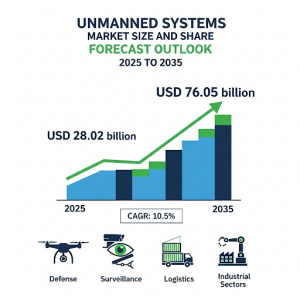Global Unmanned Systems Market to Hit USD 76.05 Billion by 2035, Fueled by Defense, Automation & Logistics Innovations
The Future of Manufacturing: Solutions-Focused Unmanned Systems Address Key Challenges in Defense Modernization and Propelling Unprecedented Growth
NEWARK, DE, UNITED STATES, August 4, 2025 /EINPresswire.com/ -- A new forecast reveals the global unmanned systems market is positioned for a transformative decade, with a projected value surge from USD 28.02 billion in 2025 to a staggering USD 76.05 billion by 2035. This robust growth, reflecting a Compound Annual Growth Rate (CAGR) of 10.5%, is a direct response to a critical need for autonomous and semi-autonomous platforms that can navigate complex global challenges—from defense and surveillance to logistics and industrial automation.
The core drivers of this growth are acutely relevant to manufacturers. Escalating geopolitical uncertainties and global defense modernization programs are creating an urgent demand for unmanned aerial (UAVs), ground (UGVs), and maritime (UMVs) vehicles. Military and law enforcement agencies are increasingly deploying these systems for critical operations like reconnaissance, surveillance, and tactical missions to mitigate human risk and enhance operational effectiveness. Manufacturers who can deliver platforms that are resilient, affordable, and capable of high-reliability performance in these demanding environments are poised to lead the market.
Top Investment Segments Signal Opportunity
Manufacturers should focus their R&D and production efforts on the segments showing the highest growth potential and investment. Unmanned Aerial Vehicles (UAVs) are the undeniable leaders, expected to hold a 25% market share in 2025. Within this segment, small UAVs are gaining significant traction. Their versatility, cost-effectiveness, and ease of deployment make them invaluable for a wide range of applications, including border surveillance, disaster management, and agricultural monitoring. Companies that can develop small UAVs with high levels of stability and advanced camera capabilities, similar to market leaders like DJI and AeroVironment, will find a significant and growing commercial and defense market, particularly for urban applications.
The shift toward semi-autonomous technology is another critical signal for manufacturers. This segment is forecast to command a dominant 48.6% market share by 2025. The reason is simple and compelling: it strikes a perfect balance between human oversight and automated decision-making. This equilibrium is a core solution for manufacturers, enhancing mission reliability while maintaining the adaptability needed for unpredictable operational settings. The success of platforms like the USA Navy’s Sea Hunter and commercial trials by companies like Amazon Prime Air showcases how systems with features like obstacle detection, sensor fusion, and autonomous navigation are optimizing performance across military, industrial, and commercial domains. By focusing on these integrated technologies, manufacturers can deliver systems that perform complex tasks while reducing the operational burden on end-users.
Furthermore, military and law enforcement applications are set to capture a commanding 57.3% share in 2025. This segment's dominance is sustained by consistent increases in defense spending and the need for advanced security solutions. Platforms employed by countries such as Israel and the USA, including loitering munitions and UGVs, demonstrate battlefield effectiveness for remote surveillance and target neutralization. For manufacturers, this presents a clear opportunity to develop solutions that enhance troop safety and support modern defense strategies.
Regional Dynamics and Growth Outlook
The market’s global expansion is not uniform, presenting specific strategic opportunities for manufacturers in different regions. India leads the world in growth with a projected CAGR of 6.5% from 2025 to 2035. This is driven by its "Make in India" initiative, which promotes domestic production of UAVs and UGVs. Manufacturers looking for high-potential growth and a new hub for development should consider this region. Similarly, the United States, with a CAGR of 5.8%, offers a strong and stable market, supported by large defense budgets and an ecosystem of R&D investments led by established players like Lockheed Martin and Northrop Grumman. For manufacturers, the US market is an accelerator for both military and civil applications, especially as favorable FAA guidelines support innovation in sectors like agriculture and last-mile delivery.
Conversely, countries like the UK (4.9% CAGR), Germany (4.7% CAGR), and Japan (4.4% CAGR) represent more mature markets with distinct needs. In Germany, manufacturers can capitalize on the country’s push for Industry 4.0, which is creating demand for UAVs and UGVs in industrial inspection and logistics. In Japan, innovation is being driven by robotics integration and a need for autonomous solutions to address labor shortages due to an aging population. Manufacturers can strategically align their offerings with these specific regional demands to achieve targeted growth.
The Competitive Landscape and a Call to Innovation
The unmanned systems market is marked by key trends that manufacturers must address head-on. The integration of artificial intelligence (AI) is no longer an option but a necessity for enhancing autonomy and meeting stringent performance requirements. Companies are also prioritizing platforms that are resilient to electronic warfare and are affordable, reflecting a shift in defense procurement strategy, as seen with the US Department of Defense’s interest in low-cost FPV drones.
For manufacturers, the path forward is clear: the market is ripe with opportunities, particularly in high-growth segments like small UAVs and semi-autonomous systems, and in rapidly expanding regions like India and the United States. Success will be defined by a commitment to strategic innovation, a focus on technological integration—especially with AI and advanced sensors—and the agility to respond to evolving defense and commercial needs. The next decade promises to be a period of significant growth and transformation, and manufacturers who prepare now will be the ones to define the future of unmanned systems.
Request Unmanned Systems Market Draft Report
https://www.futuremarketinsights.com/reports/sample/rep-gb-22355
For more on their methodology and market coverage, visit
https://www.futuremarketinsights.com/about-us.
Explore Related Insights
Unmanned Aerial Vehicle Market:
https://www.futuremarketinsights.com/reports/unmanned-aerial-vehicle-market
Unmanned Aerial Vehicles (UAV) Commercial Drone Market:
https://www.futuremarketinsights.com/reports/unmanned-aerial-vehicles-uav-commercial-drone-market
Editor's Note:
This press release has been edited for brevity, using only the provided content. It is structured to directly address manufacturers, highlighting key market challenges and growth opportunities. The document is a concise, solution-focused overview of the unmanned systems market.
Rahul Singh
Future Market Insights Inc.
+1 347-918-3531
email us here
Legal Disclaimer:
EIN Presswire provides this news content "as is" without warranty of any kind. We do not accept any responsibility or liability for the accuracy, content, images, videos, licenses, completeness, legality, or reliability of the information contained in this article. If you have any complaints or copyright issues related to this article, kindly contact the author above.
Aerospace Bearings Market to Reach USD $14.36 Billion by 2029 at 10.6% CAGR
Automatic Train Control Market CAGR to be at 8.6% from 2025 to 2029 | $5.77 Billion Industry Revenue by 2029
Automatic Track Warning System Market to Reach USD $3.02 Million by 2029 at 4.5% CAGR
Więcej ważnych informacji
 Jedynka Newserii
Jedynka Newserii

 Jedynka Newserii
Jedynka Newserii

Polityka

Polska może się stać Doliną Krzemową Europy. Potrzeba jednak wsparcia finansowego start-upów i mocniejszej deregulacji
Polskie start-upy skoncentrowane są głównie na rozwoju nowoczesnych technologii informatycznych i cyfrowych. Wyraźny nacisk na oprogramowanie i aplikacje oraz big data i data science wskazuje na silne zainteresowanie narzędziami analitycznymi i rozwiązaniami wspierającymi transformację cyfrową w różnych branżach – wynika z raportu „Rynek start-upów w Polsce. Trendy technologiczne”, który został opracowany w 2024 roku w MRiT. Zdaniem europarlamentarzystów Polska ma szansę się stać Doliną Krzemową, jednak rozwój start-upów blokowany jest m.in. przez ograniczony dostęp do finansowania oraz niekorzystne i nadmierne regulacje.
Transport
Na półmetku wakacji ceny paliw na stacjach nie powinny się wyraźnie zmienić. Znaczące różnice między regionami i stacjami

W sierpniu ceny benzyny, oleju napędowego i autogazu powinny pozostać na poziomach z lipca – uważa ekspertka rynku z firmy Reflex. Wyższe będą zawsze na stacjach premium, tych, które oferują bogatszą ofertę dodatkową, promocje dla uczestników programu lojalnościowego, oraz w regionach, w których tradycyjnie paliwa są droższe ze względu np. na wyższą siłę nabywczą mieszkańców. Różnice mogą sięgać kilkudziesięciu groszy na litrze. Obszary, wokół których te wartości oscylują, zależą z kolei od sytuacji globalnej. Warto patrzeć na sytuację na Bliskim Wschodzie i w Ukrainie.
Polityka
A. Mularczyk (PiS): Nawiązanie poważnego dialogu z Niemcami jest konieczne nie tylko w kontekście reparacji. Powinien być podpisany traktat polsko-niemiecki

– Nie wystarczy jednorazowy gest czy inicjatywa. To musi być podjęcie dialogu, być może też przygotowanie nowej umowy bilateralnej, nowego traktatu polsko-niemieckiego, który regulowałby wszystkie obszary, które wynikały ze skutków II wojny światowej – mówi Arkadiusz Mularczyk, poseł do Parlamentu Europejskiego z PiS-u. Podkreśla, że proces ten nie będzie łatwy, bo wymaga konsekwencji i stanowczości, ale widzi szansę w prezydenturze Karola Nawrockiego, który już zadeklarował kontynuację starań w tym zakresie. Zdaniem europosła wsparciem w polsko-niemieckim dialogu może być administracja Donalda Trumpa.
Partner serwisu
Szkolenia

Akademia Newserii
Akademia Newserii to projekt, w ramach którego najlepsi polscy dziennikarze biznesowi, giełdowi oraz lifestylowi, a także szkoleniowcy z wieloletnim doświadczeniem dzielą się swoją wiedzą nt. pracy z mediami.




![Nestlé w Polsce podsumowuje wpływ na krajową gospodarkę. Firma wygenerowała 0,6 proc. polskiego PKB [DEPESZA]](https://www.newseria.pl/files/1097841585/fabryka-nesquik_1,w_85,r_png,_small.png)




.gif)

 |
| |
| |
|